What Is The Difference Between Garmin Echomap Vs GPSmap Chartplotters?
UPDATED 18 SEPTEMBER 2023
by Robert Ceran
This article may contain affiliate links. If you make a purchase after clicking on a link we may earn a small commission at no extra cost to you.
The Garmin GPSmap and Echomap chartplotter lineups combine state of the art sonar with advanced mapping functionalities.
Both of these series offer some of the best fish finder electronics that money can buy.
The only problem is that they come in a wide variety of models, each with different specs and features.
So what are the key differences between the GPSmap and Echomap chartplotter series, and what are each of them ideally suited for?
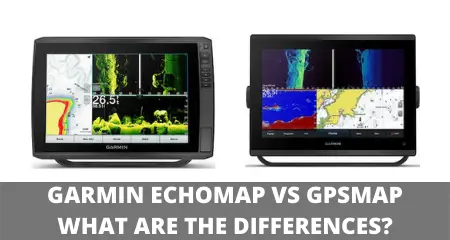
For this article we tested the Echomap vs GPSmap lineups side by side, so you can decide which one is right for your purposes.
Garmin GPSmap vs Echomap chartplotter lineups compared side by side
The table above compares the key specs of 3 GPSmap vs Echomap models that we tested.
For this Garmin chartplotter comparison we paired models of comparable size that can be used for similar purposes, and evaluated the most important differences between them.
Bottom line: While they are broadly similar, the Echomap lineup was primarily designed for use in freshwater, while the GPSmap series was primarily designed for use in saltwater.
Because of this, the GPSmap series has several extra features that are most useful in a marine environment (including optional radar functionality, as well as the ability to network with other marine electronics).
Now let’s take a closer look at the most important differences between the Echomap and GPSmap lineups.
The most important differences between the Echomap and GPSmap series
Here are the key differences between the two lineups:
Screen resolution: GPSmap units come with higher screen resolution when compared to Echomap units of similar display size.
As a result, during our testing we found that we got a clearer image and more detail on GPSmap units.
This is especially important if you’re planning to use LiveScope, where a more crisp image can make a big difference.
MicroSD card slots: While all GPSmap units come with two MicroSD card ports, Echomap UHD units only have one.
Having two card slots increases networking abilities, though you can also use networking via Wifi for some applications.
Preloaded maps: While all GPSmap units come with both LakeVu (inland) maps and BlueChart (coastal) maps preloaded, Echomap units only come with one of these options preloaded, and you have to choose which one when buying the unit.
However, you can use the microSD card slot to load more maps after purchase.
Sonar: This is an area with very few differences between the two lineups. They both have very similar sonar capabilities that include CHIRP, ClearVu (down imaging), and SideVu (side imaging).
But keep in mind that some GPSmap models are produced without sonar functionality, so if this is something you are looking for, make sure you get a GPSmap unit with xsv at the end of its name.
Radar: Radar is an optional add-on with any of the GPSmap units. If you choose this option, you’ll get a GMR 18 HD+ radome that you can mount on the top of your boat.
This only really makes sense for ocean going vessels, but not for boats that are only used in freshwater.
Networking abilities: Both lineups are designed to network with other Garmin units, but you should know that Echomap units only network with other Echomap units, and GPSmap units only network with other GPSmap units.
During our testing we found that this is important if you want to add more Garmin units to your boat later on. However, in addition to this, GPSmap units are designed to network with other marine electronics (such as wind sensors).
Helm app compatibility: The Garmin Helm app enables you to control all of your Garmin electronics from your iPhone, Android smartphone, or tablet. However, this app only works with the GPSmap series, but not the Echomap series.
Garmin Force trolling motor compatibility: All Echomap models can be networked with a Garmin Force trolling motor, which enables you to control the trolling motor directly from your chartplotter. In contrast to this, GPSmap units don’t have this feature.
Pricing: GPSmap units are significantly more expensive than Echomap UHD units of similar size, with a price difference of 500 to 1000 dollars per unit.
However, this trend is different when it comes to Echomap Ultra models, which are similarly priced to GPSmap units of comparable size.
When comparing the price of specific models, keep in mind that GPSmap units are often sold without a transducer, while Echomap units usually come with the transducer included in the package.
Now let’s take a closer look at each of the models that we tested.
Garmin Echomap UHD 73sv review
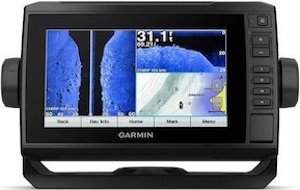

When we put it to the test, we found that with a 7 inch screen, the Echomap UHD 73sv is big enough to take advantage of split screen functionality to view more than one type of sonar side by side with mapping data.
And the great thing about the 73sv is that it comes at an affordable price, giving you access to some of the best fish finder and mapping functionalities without breaking the bank.
Features:
- 2,300 ft (freshwater) or 1,100 ft (saltwater) maximum depth
- Can record & rewind sonar data
- ClearVu CHIRP
Garmin GPSmap 743xsv review
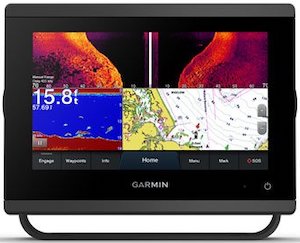

While the GPSmap 743xsv is definitely more expensive than the similarly sized Echomap UHD 73sv, and when we tested it we found that it comes with a much higher screen resolution of 1024 x 600 pixels, which gives you incredible clarity of signals on the screen.
And in contrast to the Echomap 73sv, it comes with 2 microSD slots, and with both LakeVu and BlueChart maps already preloaded.
Finally, it can also be used with radar, and is compatible with the Garmin Helm app, making it ideal for any ocean going vessel.
Features:
- 5,000 feet maximum depth
- IPX7 waterproofing
- Wireless remote control
Garmin Echomap UHD 93sv review
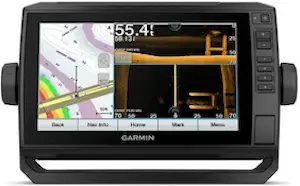

With a more generous 9 inch display, the Echomap UHD 93sv offers more screen size to take advantage of all its powerful fish finder and chartplotter features side by side.
And notwithstanding its high quality, it still retails under 900 dollars, which is great value for money.
And just like all Echomap units, the UHD 93sv can be networked with the Garmin Force trolling motor, which gives you the ability to control your trolling motor with your chartplotter.
Features:
- WVGA display
- 1 Panoptix port
- Quickdraw contour mapping
Garmin GPSmap 943xsv review
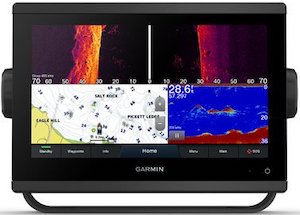

When we put it to the test we found that with a screen resolution of 1280 x 720 pixels, the GPSmap 943xsv comes with an incredibly crisp image and the ability to pick up minute details on the screen.
And its very high pixel density makes this unit ideal for reading LiveScope sonar data.
Features:
- High quality WXGA IPS display
- 2 microSD card slots
- Garmin radar compatible
Garmin Echomap Ultra 122sv review
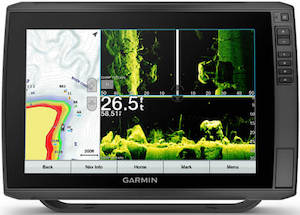

In contrast to Echomap UHD models, the Echomap Ultra 122sv comes with a much higher quality display with a screen resolution of 1280 x 800 pixels, as well as highly vivid colors.
In fact, the Echomap Ultra has the same WXGA IPS display as GPSmap units, which explains its very high image quality.
Our tests showed that this allows you to combine the best of the GPSmap series with the best of the Echomap series in one device.
Another strength of the Ultra 122sv is that it supports 4 sonar frequencies: CHIRP high wide, UHD ClearVu, CHIRP ClearVu, and UHD SideVu, which puts it ahead of Echomap UHD models in terms of sonar capabilities.
Features:
- Display can be viewed with polarized glasses (helpful in bright sunlight)
- Supports 4 sonar frequencies
- WXGA IPS display (same display as GPSmap units)
Garmin GPSmap 1242xsv review
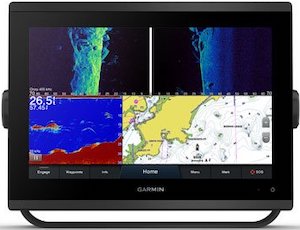

With its generous 12 inch screen and compatibility with Garmin Radar and Onehelm, the GPSmap 1242xsv is a great depth finder for ocean going boats.
The ability to network the 1242xsv with other marine electronics is a great feature, since that enables you to control the whole network from your smartphone with the Helm app.
Features:
- Records sonar readings
- Polarized display for bright sunlight
- Wireless remote compatible
What is the best chartplotter for LiveScope?
If you’re looking for the best Garmin chartplotter to use with LiveScope, our tests show that the best option is the GPSmap 1022 without sonar capabilities.
It comes with a generous 10 inch screen and a very high resolution, which is ideal for Panoptix LiveScope.
Also, since it doesn’t include sonar capabilities, it retails around 1,200 dollars, which makes it a highly affordable option.
That being said, you can also opt for smaller GPSmap or Echomap UHD units.
And in case you’re interested in learning more about budget friendly chartplotters for LiveScope, check out our article on the best LiveScope bundle for the money.
Garmin Echomap Ultra vs GPSmap – what are the differences?
The main difference between the Echomap Ultra and GPSmap lineups is the ability of GPSmap units to work with Garmin radar, Garmin Helm, and network with other marine electronics (even including some non-Garmin models).
The latter features are most useful for marine boat electronics, which makes total sense, given that the GPSmap lineup was specifically designed for saltwater use.
And finally, unlike Echomap UHD models, Echomap Ultra units come with the same high quality WXGA IPS display as GPSmap units, which explains their high resolution images.
Final remarks
This concludes our review about the Garmin GPSmap vs Echomap chartplotter lineups.
Hopefully this will help you to choose the right model for your purposes. Tight lines and see you on the water!
Gear and methods used for testing
For consistent testing results in our Garmin chartplotter comparison, we tested all fish finder units reviewed in this article with a Garmin GT56UHD-TM transducer transom mounted on a Ranger Z520R bass boat. We tested both series on the same day on Lake Tarpon, to make sure we could compare their performance side by side under similar conditions. Testing was performed by imaging structure and schools of panfish relating to that structure in 4 to 19 feet of water.





